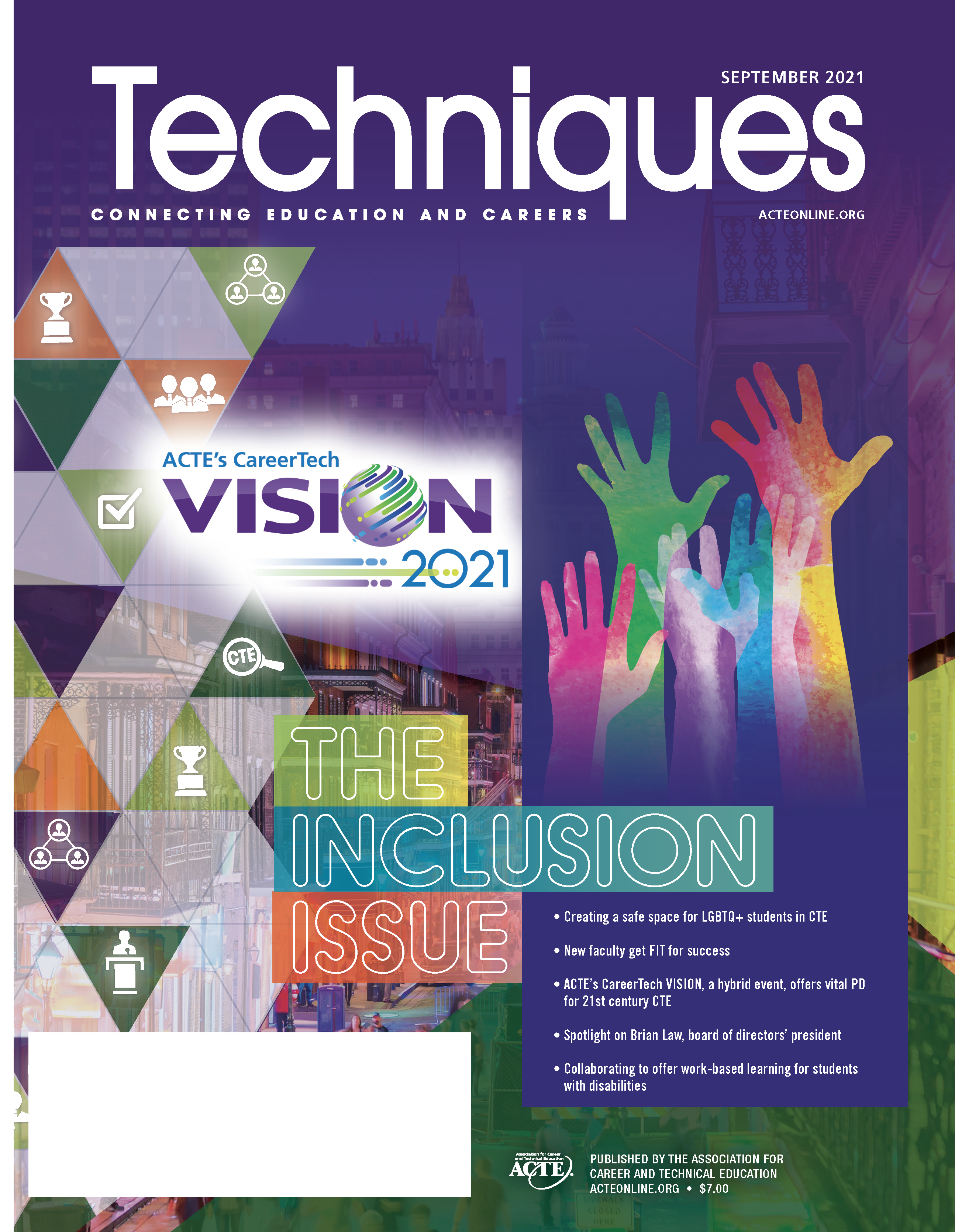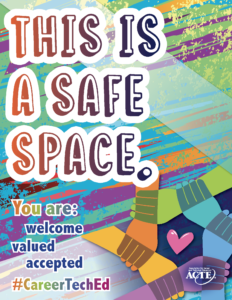Creating a safe space for LGBTQ+ students in CTE
 It’s likely you’ve taught a student who identifies as lesbian, gay, bisexual, transgender or queer (LGBTQ+). Such youth with caring adults in their lives are less likely to self-harm and more likely to thrive in CTE. Anna Hall, a family and consumer sciences educator, offers best practices for creating more inclusive learning environments.
It’s likely you’ve taught a student who identifies as lesbian, gay, bisexual, transgender or queer (LGBTQ+). Such youth with caring adults in their lives are less likely to self-harm and more likely to thrive in CTE. Anna Hall, a family and consumer sciences educator, offers best practices for creating more inclusive learning environments.
Respond to anti-LGBTQ+ language
According to a recent national school climate survey conducted by GLSEN (2020) almost all LGBTQ+ students surveyed (98.8%) reported hearing the term “gay” used in a negative or derogatory way while at school. Other research studies (Aragon, et al., 2014) indicate that students are hearing anti-LGBTQ+ language from teachers. This is
unacceptable.
I encourage you to address anti-LGBTQ+ language whenever you hear it. Start each academic term with a discussion on classroom community standards. Set expectations for student behavior, and let them know that microaggressions (such as, “That’s so gay!”) can lead others to feel they are unsafe in their learning environment.
Setting this precedent helps LGBTQ+ students feel safe and lets them know that you are an ally to them, whether or not you know their identities.
Learn the terms.
LGBTQ+ identities encompass both sexual orientation and gender. There are many different identities within the LGBTQ+ community, not all of which are expressed in the acronym. GLSEN, a national organization working to end discrimination and harassment of LGBTQ+ individuals, offers many great resources for inclusive professional development. The Safe Space Kit, for example, includes definitions for many terms you may not be familiar with. I highly suggest checking out this resource!
Select terms to know (from GLSEN Safe Space Kit):
- Ally: A member of the majority or dominant group who works to end oppression by recognizing their own privilege and supporting or advocating for the oppressed population
- Cisgender: A person whose gender identity and expression align with the gender
assigned at birth - Gender expression: The multiple ways (e.g., behaviors, dress) in which a person may
choose to communicate gender to oneself and/or to others - Gender identity: How an individual identifies in terms of their gender. Identities may include male, female, androgynous, transgender, genderqueer and many others.
- Gender nonconforming: A person who has a gender identity and/or gender expression that does not conform to the gender assigned at birth. People who identify
as “gender nonconforming” may or may not also identify as transgender. - Queer: An umbrella term used to describe sexual orientation, gender identity or gender expression that does not conform to dominant societal norms. While it is used as a neutral, or even a positive term among many LGBTQ+ people today, historically “queer” was used as a derogatory term.
Normalize pronouns.
We would never ask a student with disabilities to disclose their individualized education plan to the entire class on the first day of school. Offer this same courtesy to transgender, nonbinary, and gender non-conforming students in regard to pronouns.
For inclusivity, ask for students’ pronouns as part of a get to know you survey. And ask if their identified pronouns can be used among classmates. While you’re at it… introducing yourself with your own pronouns will signify a safe space.
“Hi, I’m Mrs. Hall, and I use she/her pronouns.”
Create a classroom culture that values respecting one another’s pronouns. Doing so will foster an inclusive environment for any student who may have been misgendered. When adults respect students’ correct pronouns, those students are less likely to attempt suicide than those who do not experience the same re.spect. Using correct names and pronouns is suicide prevention.
Add your own pronouns to your social media profiles and introduce your pronouns along with your name when you meet someone new at a conference or in an interview. Normalizing pronouns is a good practice in all facets of our lives. It takes very little effort to make this change that will help make our society more inclusive of transgender and gender-non-conforming individuals.
Use inclusive language.
Students pick up on the language we use in every.day conversations and lessons. Utilizing inclusive language helps students to feel a sense of belong.ing, and they are better able to see themselves as members of the class. For example:
The common phrase “ladies and gentlemen” excludes all students who do not identify in either of these categories. Instead, switch your practice to use of an inclusive term such as “students,” “scholars,” “professionals,” or “future [add career path here].”
Inclusive language signals to others that you are welcoming and safe I encourage you to start practicing this in all facets of your life. We can also use inclusive language when we talk with students about their personal lives.
- Don’t assume that all students have a mom and a dad. Instead, use the term “guardian” or “adult” when referring to the person you hope to see at an up.coming conference or open house.
- Don’t assume a student’s date to prom is a member of the opposite sex. Instead, use gender-neutral language when asking any follow up questions. If a student shows you a picture of their prom outfit, you might ask, “Will your date wear a coordinating color?”
Display your poster.

ACTE created a downloadable safe space poster for CTE educators to hang in offices, classrooms, hallways or gathering spaces. Safe space posters have gained popularity, especially in the higher education setting. They present a great way to let others know you are an ally to LGBTQ+ youth, colleagues or other visitors. Let the world (or at least those who spend time in your classroom or office) know that you are accepting and affirming of the LGBTQ+ community!
Download and print your copy today.
Anna Hall is a family and consumer sciences educator with a background in college administration. She also advises FCCLA and the Gender Sexuality Alliance at her school. Hall is committed to helping make schools safe and equitable for all students. She is working toward a Doctorate in Education and is interested in researching the LGBTQ+ student experience in CTE programs and how to best support this student population. In her free time, Hall enjoys spending time with her family, baking, knitting and quilting.
